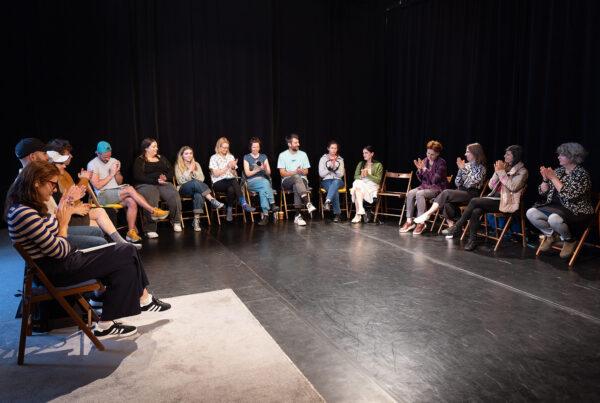Written by Caleb Lee & Chloe Stephens
“Is that a planet,” a boy who was seated amongst the audience asked his mother earnestly. “It can be anything you want it to be”, she replied with a grin. This delightful moment was observed in a performance of Rise and Fall, a poetic and charming dance-theatre production for ages two and up that is conceived by Page One Theatre (UK). Rather than a narrative, a performer single-handedly beautifully manipulates and plays with balloons of different shapes and sizes, creating an eclectic composition of floating balloons that slowly unfolds into a sensory landscape. This production, which has toured in the UK and Singapore, has received many insightful and unexpected responses. It is the minimalistic aesthetic and openness of the piece that asks the audience to stretch their imagination, fill in the blanks and create their own meanings.
With only a performer interacting with white balloons on stage, the performance form is expanded and diverges from more familiar ‘theatre’ and ‘dance’ forms to challenge the spectator’s reading. Watching and playing with the abstract can stimulate different associations and feelings in the viewer, which are more dependent on the state of mind, rather than the cognitive response to a specific message delivered by gestures. One of the most significant features of the abstract in these types of performances is that children witness a representation of the object rather than the object itself. This opens a range of possibilities that stretches the imagination of the child and can extend their thinking beyond conventional logic. For example, in a scene where the performer blows up the balloons and holds them up in both of her hands, an audience member wondered if the performer would ‘float away’. In a later scene, where the performer ‘plants’ the balloons in the ground, another audience asked if they would turn into ‘balloon flowers’. These moments are illustrative of how perceptions of the unfamiliar can pave the ways to new interpretations in children that are spontaneous, creative and surprising.
Throughout the various performances, we have often observed a chorus of hushed questions from children: “is she real?”, “why isn’t she speaking?”, “is she flying?”, “is she magic?”, “why is she doing that?”. As theatre-makers we feel that it is important to challenge audience’s perceptions and not be afraid of the unknown. These questions show that children are engaged in creating their own narrative during a performance. Quality theatre should stimulate questions, not give us the answers.
In a recent review of the performance at Little Angel Theatre in London, Mel Herring from Children’s Theatre Reviews states, “Rise and Fall is embedded in a new type of children’s theatre which really allows young people to develop their own relationship with, interpretation of, and response to, performance.” This statement is a testament to how the abstract can challenge audiences to use their imaginations, which can be an empowering, personal and transformative experience. At the end of Rise and Fall, the audiences are invited onstage to play with the balloons. In doing so, they become performers themselves as colored lights and music take them through different atmospheres. Children are now enabled and encouraged to develop their own responses to the balloons further by interacting physically, balancing them on body parts, throwing them up and catching them, floating arms up and dancing with their own balloon. Additionally, children are then offered the opportunity to take their balloon home, where they can continue dancing, dreaming and expressing themselves creatively in their own environments, long after the performance is over.
In an increasingly mediatized environment where the worlds of children are saturated with images and with children’s markets commodifying their imagination, a dance-theatre production like Rise and Fall offers young children a blank canvas where they are encouraged to wonder and wander. By going back to basics and emphasizing the importance of modest play in performances, it is a reminder that simplicity has the power to unlock and stretch the imagination of young audiences.
Caleb Lee is the Co-Artistic Director of Five Stones Theatre (SG/UK) and the Associate Researcher of Rose Bruford College TYA Centre.
Chloe Stephens is the Artistic Director of Page One Theatre and also runs the Drama department at Morley College London.



